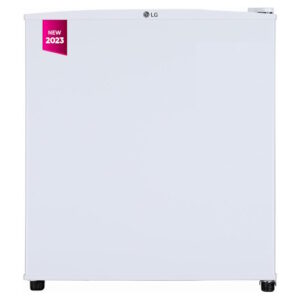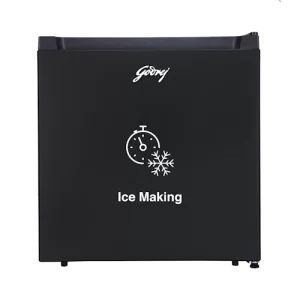Mini Fridge
-
LG 43 L 4 Star Direct Cool Single Door Mini Refrigerator (GL-M051RSWE, Super White, Fast Ice Making)
- Capacity: 43 litres
- Energy Rating 4 Star
- Warranty: 1 year on product
₹7,695.00 -
Godrej 45 L 2 Star Minibar Refrigerator With adjustable Temperature
Capacity 45 litres Configuration Center Energy Star 2 Star ₹9,489.00 -
Hisense 45 L 4 Star Direct-Cool Single Door Mini Refrigerator
Capacity 45 litres Configuration Internal Freezer Energy Star 3 Star ₹9,489.00 -
Beverage Refrigerator and Cooler, 126 Can Mini fridge with Glass Door, Small Refrigerator
- Features – built in handle, adjustable shelves, auto defrost, intelligent control, led light, reversible door, adjustable feet
- Model – BR-110-WM
- Weight – 60.4 lb
₹19,579.00 -
Auseo 4.5 Cu.ft Beverage Refrigerator and Cooler, 145 Can Mini Fridge Glass Door for Soda,Beer or Wine
- Number of Shelves – 5
- Shelf Material – Metal
- Number of Bins – 5
₹25,829.00 -
KISSAIR 3.2 Cu.ft Beverage Refrigerator Cooler -120 Can Mini Fridge, Freestanding Wine Chiller
- Number of Shelves – 3
- Shelf Material – Glass
- Weight – 51.77 lb
₹16,362.00 -
BPL 45 L Direct Cool Single Door 2 Star Refrigerator Mini Fridge
Brand BPL Capacity 45 litres Configuration Freezer Top Energy Star 2 Star ₹8,539.00 -
Kelvinator 45 L Thermoelectric Cooling Single Door 2 Star Refrigerator Mini Fridge
- Capacity: 45L
- Stabilizer Free
- Reversible Door
- Separated Chiller Compartment
₹7,399.00
Comprehensive Guide to Mini Fridges
Introduction
Mini fridges, also known as compact refrigerators, are small-sized refrigeration units that provide an efficient solution for cooling food and beverages in limited spaces. These versatile appliances are ideal for dorm rooms, offices, small apartments, and even as supplementary storage in larger kitchens. With a variety of designs and functionalities available, mini fridges have become increasingly popular among consumers seeking convenience and efficiency. This guide will explore the features, benefits, types, installation processes, maintenance tips, and frequently asked questions (FAQs) regarding mini fridges. By the end of this guide, you will have a thorough understanding of mini fridges and be well-equipped to make informed purchasing decisions for your e-commerce platform.
What is a Mini Fridge?
A mini fridge is a compact refrigeration unit designed to store food and beverages while taking up minimal space. They typically range in size from 1.7 to 4.5 cubic feet and can be used in various settings such as homes, offices, dormitories, and recreational vehicles (RVs). Mini fridges are available in several styles, including top-freezer models, bottom-freezer models, and beverage coolers.
Key Features of Mini Fridges
- Compact Size: Mini fridges are designed to fit into tight spaces, making them perfect for small living areas or as secondary refrigeration options.
- Energy Efficiency: Many mini fridges are designed with energy-efficient features that help reduce electricity consumption compared to full-sized refrigerators.
- Adjustable Shelves: Most models come with adjustable shelves that allow users to customize the interior layout based on their storage needs.
- Temperature Control: Mini fridges often feature adjustable temperature settings to ensure optimal cooling for different types of food and beverages.
- Variety of Designs: Available in various colors and finishes, mini fridges can complement any decor style.
Types of Mini Fridges
Mini fridges come in several types to cater to different needs:
- Standard Mini Fridge: These units typically include a small freezer compartment and are suitable for general food storage.
- Beverage Coolers: Designed specifically for storing drinks, these units often feature glass doors for easy visibility and adjustable shelves for different bottle sizes.
- Wine Coolers: These specialized mini fridges maintain optimal temperature and humidity levels for wine storage.
- Compact Freezers: Some mini fridges focus primarily on freezing capabilities while providing limited refrigeration space.
- Dual-Zone Mini Fridges: These models allow users to set different temperatures for various compartments, making them ideal for storing both food and beverages.
- Cosmetic Mini Fridges: Growing in popularity among beauty enthusiasts, these small units are designed specifically for storing skincare products at optimal temperatures.
Benefits of Using Mini Fridges
- Space-Saving Design: Mini fridges maximize available space in small areas while providing essential refrigeration capabilities.
- Convenience: Having a mini fridge nearby makes it easy to access snacks and beverages without needing to go to a larger refrigerator.
- Energy Efficiency: Many models consume less energy than traditional refrigerators, leading to lower electricity bills over time.
- Portability: Lightweight designs make it easy to move mini fridges from one location to another, making them ideal for dorms or RVs.
- Versatile Applications: Mini fridges can be used in various settings including homes, offices, hotels, and outdoor events.
Choosing the Right Mini Fridge
When selecting a mini fridge for your e-commerce business or personal use, consider the following factors:
- Size and Capacity: Determine how much space you have available and how much storage you need; consider both height and width when measuring your space.
- Type of Use: Decide whether you need a standard fridge with a freezer compartment or a specialized model like a beverage cooler or wine fridge based on your needs.
- Energy Efficiency Ratings: Look for models with Energy Star ratings or other certifications that indicate energy efficiency; this can save you money on electricity bills over time.
- Temperature Control Options: Consider whether you need adjustable temperature settings or dual-zone capabilities if you plan on storing different types of items.
- Design Preferences: Choose a finish that complements your existing decor; options may include stainless steel, black stainless steel, or vibrant colors.
- Budget Considerations: Set a budget based on your needs; while some high-end models offer advanced features, there are plenty of affordable options available as well.
Maintenance Tips for Mini Fridges
Regular maintenance can prolong the lifespan of your mini fridge:
- Clean Regularly: Wipe down surfaces inside and outside using mild soap and water; avoid abrasive cleaners that could damage finishes.
- Check Temperature Settings: Regularly monitor temperature settings to ensure food safety; adjust as needed based on seasonal changes or usage patterns.
- Inspect Seals and Gaskets: Check door seals periodically for wear; replace them if they appear damaged to maintain energy efficiency.
- Defrost When Necessary: If your unit has a freezer compartment that accumulates frost, defrost it as needed according to manufacturer guidelines.
- Vacuum Condenser Coils: Dust can accumulate on condenser coils over time; vacuum these coils at least once a year to maintain efficiency.
- Schedule Professional Maintenance: Consider scheduling professional service every few years for thorough inspections and maintenance tasks that may require specialized knowledge or tools.
Frequently Asked Questions (FAQs)
1. What is a mini fridge used for?
Mini fridges are versatile appliances primarily used for storing food and beverages in small spaces like dorm rooms, offices, apartments, or as supplemental refrigeration in larger kitchens.
2. How much space do I need for a mini fridge?
Most mini fridges are designed to fit standard cabinet cutouts (typically 24 inches wide). Measure your available space carefully before purchasing to ensure a proper fit.
3. Are all mini fridges energy-efficient?
Many modern mini fridges come with energy-efficient features; look for models with Energy Star ratings to ensure they consume less electricity compared to standard units.
4. Can I install a mini fridge myself?
Yes! Most installations are straightforward enough for DIY enthusiasts; however, always refer to manufacturer guidelines during installation—if electrical work is involved or if you’re unsure about any aspect of installation consider hiring a professional!
5. How do I clean my mini fridge?
Wipe down surfaces inside and out using mild soap and water; avoid abrasive cleaners that could scratch finishes—remove any spills promptly to prevent odors!
6. What should I do if my mini fridge isn’t cooling properly?
Check temperature settings first; ensure it’s plugged into a working outlet—if issues persist consult customer service support from your machine’s brand manufacturer directly!
7. Can I use my mini fridge outdoors?
Some models are specifically designed for outdoor use; check product specifications before placing any unit outside as exposure may void warranties!
Conclusion
Mini fridges offer an excellent solution for maximizing refrigeration space while maintaining aesthetic appeal in various environments! Understanding their features benefits installation processes maintenance requirements along with addressing common questions empowers consumers make informed decisions when purchasing these essential appliances online!








